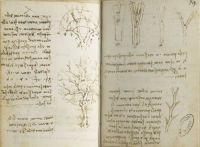The Natural World Click on the thumbnails to explore the trail
Read more about this trail (expand)
Leonardo’s endless curiosity regarding the form and function of all natural phenomena is attested to in his drawings, manuscripts and paintings. As nature could only be understood by direct “experience” or engagement with real life models, man, plants, animals, and the world that they inhabited became the subject of intense scrutiny in the quest for understanding of all natural things.

- Enlarge
- Zoom & explore
- Fol 78v-79r - Diagrammatic drawing of the growth of trees. Photo RMN - © René-Gabriel Ojéda
Paris Manuscript M Late 1490s-1500
Leonardo believed that natural laws governed the shape and form of all things. In order to be able to recreate forms in paintings, he needed to understand their underlying principles.
On Fol 78v, he set about establishing a universal rule governing the branching systems of trees, based on direct observation of nature. While he understood that branches did not grow symmetrically and that not all trees were identical, he established a general rule.
If an arc centred on the trunk of a tree is drawn through the branching system, the total sum of cross-sectional areas across that arc would be the same as the area at any other arc drawn from the same centre. This rule had a bearing on the overall shape of the tree, and so it needed to be understood by the painter who wanted to represent trees in his painting.
Eventually Leonardo realized the impossibility of task he had set for painters to understand the underlying causes of all things. In the treatise on painting, a compromise is suggested. Commitment to the study of nature will in itself ensure success.
In Leonardo's words
Hence, painter, you who do not know these laws, in order to escape the censure of those who do understand them, may it please you to portray all your subjects from nature, and do not despise study as do those who aim only for monetary gain.
The smallest of Leonardo’s surviving manuscripts, Manuscript M focuses on the study of Euclid’s geometry, ballistics and botany, with important theories regarding the growth of trees.
This notebook also provides evidence of Leonardo’s contacts with Donato Bramante, who became the most important high Renaissance architect, and designer of the new St. Peter’s Basilica in Rome.
The manuscript consists of 48 folios in their original binding.
- Medium Pen and ink on paper
- Size 10 x 7 cm
- Location Bibliothèque de l’Institut de France










